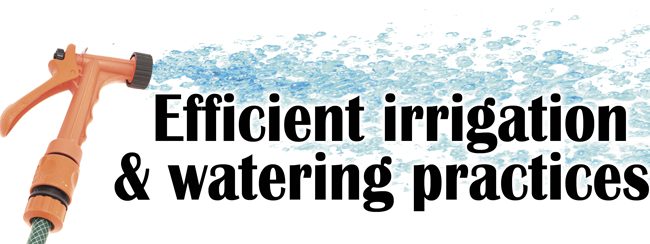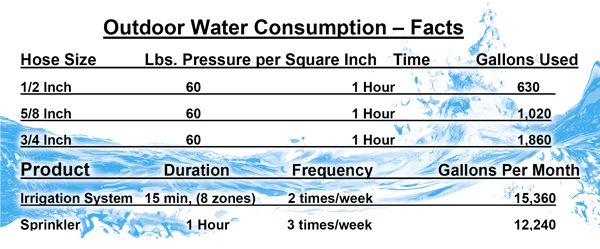

 Everyone is extra thirsty in the summer, especially when triple-digit heat arrives to Lea County. You, your pets and even your landscape and gardens cry out for a drink! Yes, during long hot summer days your trees, shrubs and other plants need a nice, cool drink of water. Summer rains are great, but the natural precipitation is not enough to cover the needs, especially in the high degree heat, winds and very low humidity factors … these conditions kind of suck the life out us and our beautiful landscapes in Lea County.
Everyone is extra thirsty in the summer, especially when triple-digit heat arrives to Lea County. You, your pets and even your landscape and gardens cry out for a drink! Yes, during long hot summer days your trees, shrubs and other plants need a nice, cool drink of water. Summer rains are great, but the natural precipitation is not enough to cover the needs, especially in the high degree heat, winds and very low humidity factors … these conditions kind of suck the life out us and our beautiful landscapes in Lea County.
Let me inform you on watering practices and becoming efficient in your use of water and delivery methods to your landscaped areas.
Pros and Cons on Irrigation Systems
 Sprinklers Systems — Sprinklers can cover small to very large areas.
Sprinklers Systems — Sprinklers can cover small to very large areas.
Manual sprinklers require the gardener to a valve/faucet, time the watering cycle and then move or shutdown the system. Automatic sprinkler systems provide a programmable controller to do the actions. They are adjustable, can be seasonally changed and set with multiple irrigation cycles.

Rain and soil moisture probes can be installed on automatic systems to turn-off irrigation when it rains or there is enough water in the soil profile.
Drip Irrigation — This is a great water-wise system for small yards, creating water zones in your landscaped areas. Drip irrigation is highly efficient and can supply from 1-4 gallons of water per hour depending on emitters used and water is applied directly to the soil. They have little water loss due to evaporation; this is a great advantage for Lea County winds, heat that suck up the water on triple digit days.
It is a good system to place under organic or rock mulches, conserving water and soaking into the soil with no mulch washed away.
 Hand Watering — The most simple and basic system … a garden hose open-end or an attached screw on sprinkler. An advantage of hand watering is that you can avoid over watering. You can use the nozzle to control the flow of water. When the water stops being absorbed into the soil its time to move to another location.
Hand Watering — The most simple and basic system … a garden hose open-end or an attached screw on sprinkler. An advantage of hand watering is that you can avoid over watering. You can use the nozzle to control the flow of water. When the water stops being absorbed into the soil its time to move to another location.
Check watering depth with a screwdriver or rod to see if the water has soaked 6 to 10 inches deep.
When to Water/Irrigate — Newly planted trees and shrubs require frequent watering than established plants. They should be watered at planting time and at these intervals:
✿ 1-2 weeks after planting, water daily.
✿ 3-12 weeks after planting, water every 2-3 days.
✿ After 12 weeks, water weekly until roots are established and new growth is seen.
How long does it take for a tree and shrub roots to become established?
Newly planted shrubs are considered established when their roots spread equals the spread of the above-ground leaf canopy. This can take one to two years in Lea County and does vary with plant types planted.
Establishment times for trees increases with tree size. Trunk caliper at planting time can be used to determine the time it takes for roots to establish in our Lea County soils which are variable from one end of the County to the other.

Find the caliper of your tree:
✿ Measure the trunk diameter at 6-inches above the ground for diameters up to 4-inches.
✿ If the diameter is more than 4-inches, measure at 12-inches above the ground.
How much to water:
✿ Newly planted trees apply 1-1.50 gallons per inch of stem caliper at each watering (see table).
✿ When watering newly planted shrubs, apply a volume of water that is 1/4 – 1/3 of the volume of the container that the shrub purchased in.
✿ As roots grow and spread, irrigation volume must be increased
Where to water:
✿ Apply directly over the root ball mass.
✿ Be sure to keep the backfilled soil in the planting hole moist. This encourages new roots to expand beyond the root ball mass an eventually into your landscape soil profile.
✿ A tree’s roots will spread growth 12-18 inches outwards in Lea County soils, so expand the area being watered over time.
✿ Create a water reservoir at the plants root ball 3 to 4 inches high to hold water and let infiltrate the soil.
✿ This is a great time to use Treegator bags or a drip system to slowly soak into the soil and root zone of the trees or shrubs planted. A Treegator bag will hold 15 gallons of water and release a slow trickle over 5-9 hours to the plant.
✿ Water deeply and infrequently and slowly, the goal is to get the roots going after water moisture deeply in the soil. We DO NOT want surface roots as this will cause other gardening issues in due time and/or loss of the tree or shrub.
Utilizing Mulches — Wood chips, grass clippings, leaves, pine needles, straw hay are examples of organic mulches to use under the new tree and shrub canopy. Crushed gravels, river cobblestone can be used as a mulch to help conserve water moisture in the root zones as with the organics.
Use a 3 to 4-inch depth layer of mulch around and under the leafy canopy and out to the drip line. Do not pile mulch materials up against the tree trunk base or shrub stems. You can cause viral wood rots to infect the plants and potentially kill your hard-earned investment in the landscape … keep mulch 1-inch deep at these sites.
Mulches will help in control of weed seed germination and keep the soil several degrees cooler that will foster better root establishment. Mulching will lessen weed-eating and mowing damages to trunk.

















